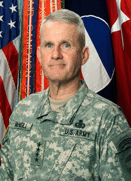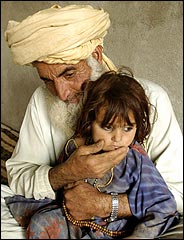Today, according to
an article published in 3 month's time, Dilawar was taken into custody at Bagram. Dilawar was a taxi driver and father to a two-year-old little girl. In five days time, he will be dead.
In an article in the NYT (reprint) on 04 March 2003 Lt. Gen. Daniel K. McNeill will provide the following quote regarding the recent deaths at Bagram:
"Our interrogation techniques are adapted," [General McNeill] said. "They are in accordance with what is generally accepted as interrogation techniques..."
"We haven't found anything that requires us to take extraordinary action..."
As described in
an article for the International Herald Tribune:
Military spokesmen maintained that both men [referring also to Habibullah, who also died at Bagram around the same time] had died of natural causes, even after military coroners had ruled the deaths homicides. Two months after those autopsies, the American commander in Afghanistan, then-Lt. Gen. Daniel K. McNeill, said he had no indication that abuse by soldiers had contributed to the two deaths. The methods used at Bagram, he said, were "in accordance with what is generally accepted as interrogation techniques."
Through an article published in over two year's time, we will learn that Dilawar was beaten to death by US soldiers.
"He screamed out, 'Allah! Allah! Allah!' and my first reaction was that he was crying out to his god," Specialist Jones said to investigators. "Everybody heard him cry out and thought it was funny."
...It became a kind of running joke, and people kept showing up to give this detainee a common peroneal strike just to hear him scream out 'Allah,' " he said. "It went on over a 24-hour period, and I would think that it was over 100 strikes."
"I saw the bruise because his pants kept falling down while he was in standing restraints," the soldier told investigators. "Over a certain time period, I noticed it was the size of a fist."
The article will describe in devastating detail how the brutality with which he was treated resulted in his death
... Mr. Dilawar grew desperate, he began crying out more loudly to be released. But even the interpreters had trouble understanding his Pashto dialect; the annoyed guards heard only noise. ... he was unable to hold his cuffed hands above his head as instructed, prompting Sergeant Salcedo to slap them back up whenever they began to drop. ... at one point Selena stepped on his bare foot with her boot and grabbed him by his beard and pulled him towards her," he went on. "Once Selena kicked Dilawar in the groin, private areas, with her right foot. She was standing some distance from him, and she stepped back and kicked him. ... it was pushing, shoving, kicking and shouting at him ... he grabbed him by the shirt and pulled him towards him, across the table, slamming his chest into the table front. ... Mr. Dilawar was unable to kneel, the interpreter said, the interrogators pulled him to his feet and pushed him against the wall ... Dilawar was trying to cooperate, but he couldn't physically perform the tasks ...
(Those who are interested in this sort of thing can read the full article themselves.)
On 13 December 2002, Maj. Elizabeth A. Rouse, a pathologist with the Armed Forces Institute of Pathology, will sign and date Dilawar's death certificate. She will write that he died as a result of "blunt force injuries to lower extremities complicating coronary artery disease" (source). Rouse later described the tissue in Dilawar's legs for investigators as "pulpified."
"I've seen similar injuries in an individual run over by a bus," she added (source).
During the trial for Dilawar's death, the accused will reveal that the methods that they used were commonly used, and that they were trained to use them (source)
In the first interview granted by any of the accused soldiers, a former guard charged with maiming and assault said that he and other reservist military policemen were specifically instructed at Bagram how to deliver the type of blows that killed the two detainees, and that the strikes were commonly used when prisoners resisted being hooded or shackled.
"I just don't understand how, if we were given training to do this, you can say that we were wrong and should have known better," said the soldier, Pvt. Willie V. Brand, 26, of Cincinnati, a father of four who volunteered for tours in Afghanistan and Kosovo.
On
28 September 2005, interrogator Sgt. Joshua R. Claus will be sentenced to five months prison for "maltreatment and assault". The charges for the murder of Dilawar are as follows (
source):
- Spc. Brian E. Cammack;
Crime: Abuse;
Sentence: Three months in prison, and a bad-conduct discharge.
- Pfc. Willie Brand;
Crime: Assault, maltreatment, maiming and making a false official
statement;
Sentence: A reduction in rank and pay to a private;
Admitted to assaulting Dilawar over 30 times in the legs.
- Sgt. Selena Salcedo;
Crime: Assault, maltreatment, maiming and making a false official
statement;
Sentence: A reduction in rank and pay to a private.
- Spc. Joshua Claus;
Crime: Dereliction of duty and assault;
Sentence: Demoted, given a letter of reprimand and ordered to forfeit
$250 a month for four months;
- Spc. Glendale Walls;
Crime: Dereliction of duty and assault;
Sentence: Two months in prison, reduced in rank and pay and a
bad-conduct discharge;
Admitted to pushing Dilawar against a wall. He also admitted doing
nothing to prevent other soldiers at the US base at Bagram from
abusing him.
- Sgt. James P. Boland;
Crime: Dereliction of duty and assault;
Sentence: Charges were dropped. A letter of reprimand was issued.
----
The following is a timeline. It reveals several lies that were told regarding Dilawar's and Habibullah's murder:
- 10 December 2002: Dilawar "found collapsed in his cell" (source).
- 13 December 2002: Maj. Elizabeth A. Rouse, a pathologist with the Armed Forces Institute of Pathology, based in Washington, signs Dilawar's certificate saying that he died as a result of "blunt force injuries to lower extremities complicating coronary artery disease". Based on this, she indicates "homicide" as the cause of death (04 March 2003, NYT).
- 17 January 2003: Dilawar's brother Shahpoor collects Dilawar's corpse and his death certificate. Shahpoor is unable to read the content of the certificate, and no one explains it to him.
- In the aftermath of the deaths, military spokespersons maintain that both Dilawar and Habibullah (who died around the same time) had died from natural causes (21 May 2005, International Herald Tribune).
- 04 March 2003: NYT article (reprint) discusses the start of the US investigation into Dilawar's homicide, and quotes one Lt. Gen. Daniel K. McNeill saying that the men's treatment was accordance with what is generally accepted as interrogation techniques..." and "We haven't found anything that requires us to take extraordinary"
- 04 August 2002: An accused soldier reveals that he was specifically instructed in the type of blows that killed Dilawar and Habibullah (08 August 2005, New York Times (reprint at ICH)).
- 28 September 2005: The heaviest sentence anyone received for the murders -- 5 months.
----
Further reading on Dilawar:






